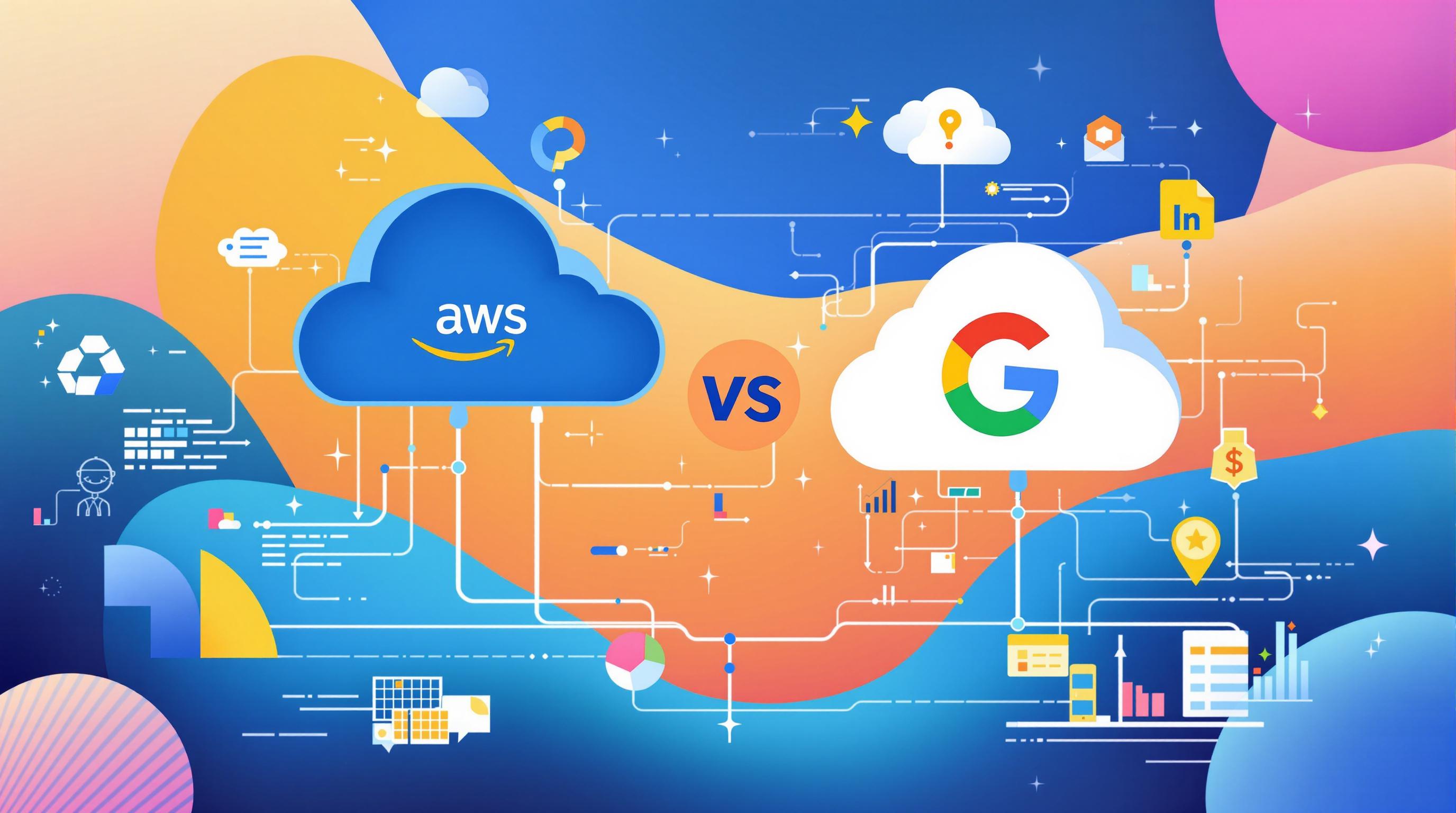
Back to Blogs
Choosing the Right Cloud AI Platform: AWS vs. Google Cloud AI for Enterprise Applications
Technology
Choosing the Right Cloud AI Platform: AWS vs. Google Cloud AI for Enterprise Applications
Choosing between AWS and Google Cloud AI can significantly impact your business's AI strategy. Here's a quick breakdown to help you decide:
- AWS: Best for large-scale enterprise solutions, strict compliance needs, and handling complex workflows. Its SageMaker platform offers deep customization for machine learning.
- Google Cloud AI: Excels in data analytics, machine learning, and multi-cloud flexibility. Vertex AI simplifies AI/ML workflows and integrates seamlessly with tools like BigQuery.
Quick Comparison
| Feature | AWS | Google Cloud AI |
|---|---|---|
| Core Strength | Enterprise AI, large-scale solutions | Generative AI, advanced analytics |
| AI Platform | SageMaker | Vertex AI |
| Integration | Complex enterprise workflows | Multi-cloud, Google ecosystem |
| Pricing Model | Reserved instance discounts | Sustained usage discounts |
| Best For | Healthcare, finance, government | Data-driven organizations |
Key takeaway: Choose AWS for large-scale operations and compliance-heavy industries. Opt for Google Cloud AI if your focus is on analytics, generative AI, or multi-cloud flexibility.
Comparing Features: AWS vs. Google Cloud AI

Scalability and Enterprise Performance
AWS operates a massive global network with over 84 data centers, ensuring low latency and reliable performance. This makes it a strong choice for businesses with operations spread across different regions. Its infrastructure is designed to handle heavy workloads, making it suitable for critical applications that can't afford downtime.
Google Cloud AI, on the other hand, shines in handling large-scale data analytics. Tools like BigQuery allow businesses to run fast, complex SQL queries, making it a go-to option for organizations that rely heavily on data-driven insights and real-time decision-making.
Integration with Existing Systems
Smooth integration is a priority for enterprises to avoid disruptions and maximize their cloud AI investments. AWS and Google Cloud AI offer different strengths when it comes to system integration:
| Integration Aspect | AWS | Google Cloud AI |
|---|---|---|
| Third-party Tools | Broad compatibility with numerous tools | Simplifies hybrid and multi-cloud setups |
| Ecosystem Support | Strong integration with enterprise tools | Works seamlessly with Google services |
| Development Framework | Flexible API options | Emphasis on open-source technologies |
Google Cloud AI's open structure makes it easier for businesses to adopt hybrid and multi-cloud setups without needing to overhaul existing systems. This approach allows companies to continue using their current infrastructure while integrating cloud-based AI solutions.
AI and Machine Learning Tools
Both platforms provide powerful tools for creating and deploying AI and machine learning solutions, catering to a variety of business needs. AWS SageMaker offers deep customization for building and deploying ML models, including advanced features like distributed training.
Google Cloud AI simplifies the process for companies without extensive ML expertise through AutoML Beta, which enables high-quality model training with minimal effort.
"The choice between these platforms often comes down to existing infrastructure, specific use cases, and the organization's data strategy." - Ankur's Newsletter, 2024-10-31 [2]
Here’s a closer look at their AI and ML capabilities:
| Feature | AWS SageMaker | Google Cloud AI |
|---|---|---|
| Model Development | Highly customizable workflows | Streamlined with AutoML |
| Data Processing | Standard ML pipelines | BigQuery-powered analytics |
| Deployment Options | Flexible across AWS services | Container-based with Vertex AI |
Google Cloud AI's Vertex AI platform stands out for its intuitive interface and container-based model development. This approach simplifies machine learning workflows while maintaining strong functionality.
These tools underscore the platforms' distinct ways of addressing enterprise AI needs, paving the way for a closer look at their cost structures.
Understanding Costs: Pricing and Budgeting
Comparing Pricing Models
AWS and Google Cloud AI offer different pricing structures tailored to various business needs. Google Cloud AI provides automatic discounts for consistent usage. These discounts kick in when resources are used for more than 25% of the month and grow as usage increases, making it ideal for businesses with steady workloads.
AWS, on the other hand, uses a flexible pricing system:
| Feature | AWS | Google Cloud AI |
|---|---|---|
| Base Pricing | Pay-as-you-go | Usage-based consumption |
| Discount Options | Reserved and Spot instances | Sustained use discounts |
| Special Pricing | Volume-based discounts | Flat-rate options for specific services |
| Free Tier | Limited resources and time | Generous free credits for new users |
For example, Google Cloud AI's BigQuery offers a flat-rate pricing model at $10,000 per month for a dedicated processing slot. This is particularly useful for enterprises with high query volumes that need predictable costs.
Tips for Reducing Costs
Managing cloud AI costs effectively can make a big difference. Here are some strategies to consider:
For AWS:
- Match instance sizes to your actual usage.
- Save up to 72% by using reserved instances for predictable workloads.
- Use spot instances for tasks that are flexible and non-critical.
For Google Cloud AI:
- Customize VMs to align resources with your specific needs.
- Use preemptible VMs for batch processing to cut costs.
- Opt for BigQuery’s flat-rate pricing if you handle large-scale data processing.
Google Cloud AI also offers cost-effective options for AI/ML services. For instance, free usage tiers are available for tools like Dialogflow and Cloud Vision API, making it easier for businesses to experiment or scale applications.
Both platforms also provide detailed analytics and monitoring tools to help track spending and find cost-saving opportunities. Understanding these pricing models and strategies sets the stage for exploring how these tools solve real-world business challenges.
Use Cases: How AWS and Google Cloud AI Are Used
Improving Customer Service and Workflow Automation
Big companies are using AWS and Google Cloud AI to reshape how they operate. Take Netflix, for example. Using AWS, their recommendation system drives a whopping 80% of viewer activity for its 230 million subscribers by offering personalized content suggestions.
On the other hand, Google Cloud AI powers Domino's Pizza's virtual assistant, DOM. This tool has boosted order completion rates by 25% and shaved 3 minutes off the average order time across various channels.
Here’s how each platform plays a role in workflow automation:
- AWS helps Netflix handle huge amounts of viewing data to deliver real-time recommendations.
- Google Cloud AI supports Domino's predictive ordering system, improving the overall customer experience.
- Both platforms make it possible to scale automation for enterprises while keeping operational demands low.
Data Analysis and Business Insights
AWS and Google Cloud AI are also game-changers when it comes to turning raw data into meaningful insights. Airbnb, for instance, uses AWS to analyze billions of interactions between guests and hosts daily. This allows them to fine-tune their matching algorithms and pricing strategies in real time, processing over 50 petabytes of data to guide decisions.
Meanwhile, Coca-Cola uses Google Cloud AI to streamline its global supply chain and marketing strategies. This has cut their analysis time by 30%. Both platforms offer features like:
- Real-time data processing to enable faster decisions.
- Ready-to-use models for common business challenges.
- Built-in visualization tools to make insights easier to act on.
These examples highlight how AWS is particularly strong in handling large-scale operations, while Google Cloud AI shines in customer-focused automation and analytics. Choosing between the two comes down to your specific needs, existing tools, and business goals.
Cloud Provider Comparisons: AWS vs Azure vs GCP - Artificial Intelligence and Machine Learning
Making the Right Choice: Factors to Evaluate
When selecting a platform, businesses need to align their specific needs with the strengths of each option. AWS is known for handling large-scale enterprise solutions, while Google Cloud AI stands out in data analytics and machine learning.
Here’s how companies are putting these platforms to work: Netflix relies on AWS to manage its recommendation system for over 230 million subscribers. On the other hand, Domino's leverages Google Cloud AI's predictive tools to improve customer service and cut down order times.
"The choice between these platforms often comes down to existing infrastructure, specific use cases, and the organization's data strategy" [2]
Platform Strengths by Business Priority
| Business Priority | Best Platform Choice |
|---|---|
| Managing Global Operations & Complex Workloads | AWS |
| Advanced Data Analytics & Machine Learning | Google Cloud AI |
| Ensuring Regulatory Compliance | AWS |
| Multi-cloud Deployment Flexibility | Google Cloud AI |
Security and Platform Alignment
Security and compliance are critical factors, and each platform has its own strengths. AWS is well-known for its extensive security tools and certifications, making it a strong choice for industries with strict regulations. Meanwhile, Google Cloud AI offers a flexible architecture that supports multi-cloud strategies, making it easier to integrate with various systems.
Key security and compliance highlights:
- AWS stands out with a broader range of certified frameworks and built-in security tools.
- Google Cloud AI focuses on flexible deployment options and robust data protection.
- Both platforms provide enterprise-grade support, with AWS offering detailed service plans and Google Cloud AI bringing specialized expertise in AI and machine learning.
Ultimately, the best platform will depend on your organization’s specific needs. Matching platform features with business priorities - while ensuring strong security measures - can help businesses fully tap into the power of cloud AI for tasks like workflow automation and data analysis.
Conclusion: Deciding on the Best Cloud AI Platform
Summary of Key Points
AWS and Google Cloud AI cater to different enterprise needs, each excelling in specific areas. Here's a quick comparison:
| Aspect | AWS Advantage | Google Cloud AI Advantage |
|---|---|---|
| Core Focus | Enterprise AI & Large-Scale Solutions | Generative AI & Advanced Analytics |
| Integration | Complex Enterprise Workflows | Data Analytics & Multi-cloud Options |
| Industry Fit | Healthcare, Finance, Government | Data-Driven Organizations |
| Cost Model | Reserved Instance Discounts | Sustained Usage Discounts |
Final Thoughts and Recommendations
AWS is the better choice if your organization:
- Needs to meet strict compliance in sectors like healthcare, finance, or government.
- Handles large-scale AI deployments requiring integration with complex enterprise systems.
Google Cloud AI is ideal if your organization:
- Focuses on generative AI or advanced analytics.
- Requires flexible multi-cloud capabilities paired with strong data processing tools.
"The effectiveness of each platform often depends on the types of AI projects being undertaken, with AWS leading in traditional AI implementations and Google Cloud AI showing particular strength in GenAI projects" [1].
Real-world examples highlight these strengths. Netflix uses AWS for its large-scale recommendation systems, while Domino's relies on Google Cloud AI to power customer service automation. Both platforms also stand out in cost management, offering savings through reserved instances (AWS) or sustained usage discounts (Google Cloud AI).
Ultimately, the best choice depends on your organization's data strategy, existing infrastructure, and long-term AI goals. Both platforms provide powerful tools, but understanding their unique approaches will help you make the right decision for your cloud AI journey.
FAQs
Is GCP more expensive than AWS?
No, Google Cloud Platform (GCP) is often more budget-friendly than AWS for enterprise AI workloads. It can deliver 25-50% savings on sustained tasks like data analytics and machine learning training. This is thanks to GCP's pricing model and built-in cost-saving features:
| Pricing Feature | GCP | AWS |
|---|---|---|
| Billing | Per-minute billing with automatic sustained-use discounts | Per-hour billing with reserved instances |
| Cost-Saving Options | Custom VMs and low-cost temporary VMs | Standard and spot instances |
GCP's pricing model stands out in several ways:
- BigQuery's flat-rate pricing ensures predictable costs for large-scale data projects.
- Automatic sustained-use discounts apply without requiring upfront commitments.
- Custom VM configurations allow for tailored resource allocation.
For example, GCP's temporary VMs and sustained-use discounts can significantly lower costs, while AWS's reserved instances are better for long-term, predictable workloads. To maximize savings on either platform, monitor usage closely and take advantage of cost-saving options like GCP's temporary VMs or AWS's spot instances for non-critical tasks.
That said, the overall cost depends on your organization's unique requirements, existing infrastructure, and long-term goals. While GCP may offer lower base prices, factors like scalability, platform features, and alignment with business objectives should also be considered. For a deeper dive into pricing models and strategies, check out the "Understanding Costs" section.
Related Blogs

Technology
15 Jan 2025
Reimagining SaaS Product Development: Harnessing Cloud AI for Faster, Smarter Delivery
Explore how Cloud AI is revolutionizing SaaS development by enhancing efficiency, user experience, and cost-effectiveness.

Technology
15 Jan 2025
Maximize Your Generative AI Investment: Practical Strategies for Transformational ROI
Learn practical strategies for maximizing ROI from generative AI by aligning projects with business goals and ensuring scalable systems.

Technology
15 Jan 2025
Cloud-Based Generative AI: 10 Ways to Transform Business
Discover how cloud-based generative AI is revolutionizing business operations, enhancing customer experiences, and driving innovation.